Axis Communications M1011, 1011W, M1031W User Manual

USER’S MANUAL
AXIS M1011 Network Camera
AXIS 1011W Network Camera
AXIS M1031W Network Camera

Notices
This manual is intended for administrators and users of the AXIS M1011/M1011W/M1031W Network Camera, and is applicable for firmware release 5.00 and later. It includes instructions for using and managing the camera on your network. Previous experience of networking will be of use when using this product. Some knowledge of UNIX or Linux-based systems may also be beneficial, for developing shell scripts and applications. Later versions of this document will be posted to the Axis Website, as required. See also the product’s online help, available via the Web-based interface.
Liability
Every care has been taken in the preparation of this manual. Please inform your local Axis office of any inaccuracies or omissions. Axis Communications AB cannot be held responsible for any technical or typographical errors and reserves the right to make changes to the product and manuals without prior notice. Axis Communications AB makes no warranty of any kind with regard to the material contained within this document, including, but not limited to, the implied warranties of merchantability and fitness for a particular purpose. Axis Communications AB shall not be liable nor responsible for incidental or consequential damages in connection with the furnishing, performance or use of this material.
Intellectual Property Rights
Axis AB has intellectual property rights relating to technology embodied in the product described in this document. In particular, and without limitation, these intellectual property rights may include one or more of the patents listed at http://www.axis.com/patent.htm and one or more additional patents or pending patent applications in the US and other countries.
This product contains licensed third-party software. See the menu item “About” in the product’s user interface for more information.
This product contains source code copyright Apple Computer, Inc., under the terms of Apple Public Source License 2.0 (see http://www.opensource.apple.com/apsl/).
The source code is available from: http://developer.apple.com/darwin/projects/bonjour/
Equipment Modifications
This equipment must be installed and used in strict accordance with the instructions given in the user documentation. This equipment contains no user-serviceable components. Unauthorized equipment changes or modifications will invalidate all applicable regulatory certifications and approvals.
Trademark Acknowledgments
Apple, Boa, Bonjour, Ethernet, Internet Explorer, Linux, Microsoft, Mozilla, Netscape Navigator, OS/2, Real, QuickTime, UNIX, Windows, WWW are registered trademarks of the respective holders. Java and all Java-based trademarks and logos are trademarks or registered trademarks of Sun Microsystems, Inc. in the United States and other countries. Axis Communications AB is independent of Sun Microsystems Inc.
UPnPTM is a certification mark of the UPnPTM Implementers Corporation.
Support
Should you require any technical assistance, please contact your Axis reseller. If your questions cannot be answered immediately, your reseller will forward your queries through the appropriate channels to ensure a rapid response. If you are connected to the Internet, you can:
•download user documentation and firmware updates
•find answers to resolved problems in the FAQ database. Search by product, category, or phrases
•report problems to Axis support by logging in to your private support area
•visit Axis Support at www.axis.com/techsup
AXIS M1011/M1011W/M1031W - Notices
AXIS M1011/M1011W/M1031W Network Camera User’s Manual
Rev. 1.0
Copyright© Axis Communications AB, 2008
December 2008 Part no. 34147

AXIS M1011/M1011-W/M1031-W - Table of contents
Notices . . . . . . . . . . . . . . . . . . . . . . . . . . . . . . . . . . . . . . . . . . . . . . . . . . . . . . . . . . . . . . . . . . . . . . . . . . . . . . . . . . . . . . . . . |
. 2 |
Product Description . . . . . . . . . . . . . . . . . . . . . . . . . . . . . . . . . . . . . . . . . . . . . . . . . . . . . . . . . . . . . . . . . . . . . . . . . . . . . . . |
. 4 |
Key features |
4 |
Overview |
5 |
Accessing the Camera . . . . . . . . . . . . . . . . . . . . . . . . . . . . . . . . . . . . . . . . . . . . . . . . . . . . . . . . . . . . . . . . . . . . . . . . . . . . . |
. 7 |
Access from a browser |
7 |
Setting the root password |
8 |
Access from the Internet |
8 |
The Live View page |
10 |
Video Streams . . . . . . . . . . . . . . . . . . . . . . . . . . . . . . . . . . . . . . . . . . . . . . . . . . . . . . . . . . . . . . . . . . . . . . . . . . . . . . . . . . . |
12 |
How to stream MPEG-4/H.264 |
12 |
Motion JPEG |
13 |
Alternative methods of accessing the video stream |
13 |
Video & Audio Settings . . . . . . . . . . . . . . . . . . . . . . . . . . . . . . . . . . . . . . . . . . . . . . . . . . . . . . . . . . . . . . . . . . . . . . . . . . . . |
14 |
Video Stream |
14 |
Stream Profiles |
15 |
Camera Settings |
16 |
Overlay Image |
16 |
Privacy mask |
17 |
Audio Settings (AXIS M1031-W) |
17 |
Audio Clips (AXIS M1031-W) |
18 |
Live View Configuration . . . . . . . . . . . . . . . . . . . . . . . . . . . . . . . . . . . . . . . . . . . . . . . . . . . . . . . . . . . . . . . . . . . . . . . . . . . |
19 |
Layout |
19 |
Event Configuration . . . . . . . . . . . . . . . . . . . . . . . . . . . . . . . . . . . . . . . . . . . . . . . . . . . . . . . . . . . . . . . . . . . . . . . . . . . . . . . |
21 |
Event Servers |
21 |
Event Types |
21 |
Camera Tampering |
23 |
Motion Detection |
24 |
Port Status |
25 |
System Options . . . . . . . . . . . . . . . . . . . . . . . . . . . . . . . . . . . . . . . . . . . . . . . . . . . . . . . . . . . . . . . . . . . . . . . . . . . . . . . . . . |
26 |
Security |
26 |
Date & Time |
27 |
Network |
27 |
Ports & Devices |
33 |
LED Settings |
33 |
Maintenance |
33 |
Support |
33 |
About . . . . . . . . . . . . . . . . . . . . . . . . . . . . . . . . . . . . . . . . . . . . . . . . . . . . . . . . . . . . . . . . . . . . . . . . . . . . . . . . . . . . . . . . . . |
35 |
Resetting to the Factory Default Settings . . . . . . . . . . . . . . . . . . . . . . . . . . . . . . . . . . . . . . . . . . . . . . . . . . . . . . . . . . . . . |
35 |
Troubleshooting . . . . . . . . . . . . . . . . . . . . . . . . . . . . . . . . . . . . . . . . . . . . . . . . . . . . . . . . . . . . . . . . . . . . . . . . . . . . . . . . . . |
36 |
Upgrading the Firmware |
36 |
Technical Specifications . . . . . . . . . . . . . . . . . . . . . . . . . . . . . . . . . . . . . . . . . . . . . . . . . . . . . . . . . . . . . . . . . . . . . . . . . . . |
41 |
General performance considerations |
43 |
Glossary of Terms . . . . . . . . . . . . . . . . . . . . . . . . . . . . . . . . . . . . . . . . . . . . . . . . . . . . . . . . . . . . . . . . . . . . . . . . . . . . . . . . . |
44 |
Index . . . . . . . . . . . . . . . . . . . . . . . . . . . . . . . . . . . . . . . . . . . . . . . . . . . . . . . . . . . . . . . . . . . . . . . . . . . . . . . . . . . . . . . . . . . |
50 |
3
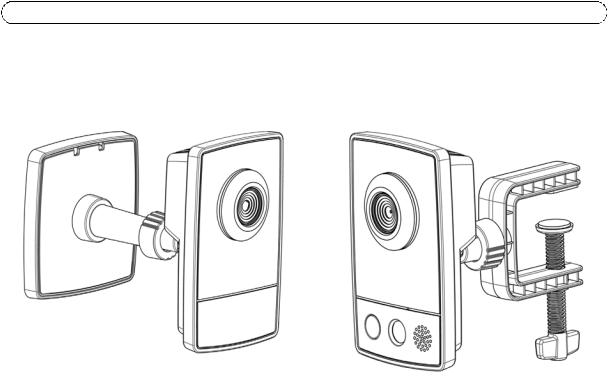
AXIS M1011/M1011-W/M1031-W - Product Description
Product Description
This manual applies to the AXIS M1011/M1011-W/M1031-W Network Camera. The information provided here applies to all models, except where otherwise indicated.
Key features
•Attractive, small-sized design
These small, smart-looking and yet discreet cameras are perfectly suited for securing small businesses, boutiques, restaurants, hotels or residences.
•Progressive scan
The cameras use progressive scan technology, providing VGA images of moving objects with no distortion.
•Multiple H.264 streams
Multiple H.264 and Motion JPEG streams can be provided simultaneously, individually optimized for different quality needs and bandwidth constraints. These cameras support MPEG-4 Part 2 for backward compatibility.
•Easy and flexible installation
AXIS M1011/M1011-W/M1031-W Network Cameras are easy to install, with the -W variants optionally offering wireless connectivity for added flexibility.
•Advanced security and network management
Axis network cameras offer advanced security and network management features such as HTTPS encryption with preserved performance, IPv6 and Quality of Service.
•PIR Sensor (AXIS M1031-W)
Complementing the video motion detection capability of the cameras, the full-featured AXIS M1031-W additionally integrates a PIR Sensor for detecting movements - even in the dark.
•Illumination (AXIS M1031-W)
AXIS M1031-W offers a white LED for illuminating the scene automatically at an event or when requested by the user.
•Microphone and speaker (AXIS M1031-W)
AXIS M1031-W provides two-way audio support with integrated microphone and speaker, allowing remote listening in on an area as well as communication with persons entering the scene. An event can trigger the sound of an audio clip, stored in the camera, to be emitted through the speaker.
4
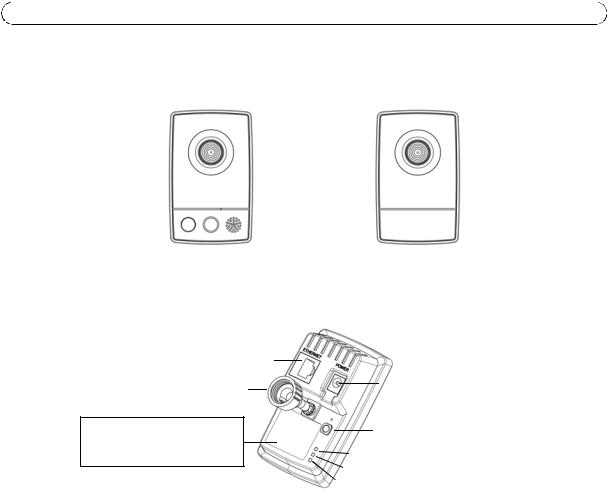
AXIS M1011/M1011-W/M1031-W - Product Description
Overview
|
AXIS M1031-W |
|
AXIS M1011/-W |
||||||
Lens with |
|
|
|
|
|
|
Lens with |
|
|
|
|
|
|||||||
Status Indicator |
Status Indicator |
||||||||
LED |
LED |
||||||||
|
|
|
|
|
|
|
Microphone |
||
|
|
|
|
|
|
|
|||
|
|
|
|
|
|
|
|
|
|
|
|
|
|
|
|
|
|
|
|
|
Light |
|
|
|
|
|
|
|
|
|
Speaker |
|
|
|
|||||
|
|
|
|
|
|
|
|
||
|
|
|
|
|
Rear view |
||||
|
PIR Sensor |
||||||||
|
|
|
|
|
|
|
(both models) |
||
Network connector
Lock ring
Product ID & Serial number (S/N). The serial number may be
required during the installation.
Power connector
Control button
Power Indicator LED
 Network Indicator LED
Network Indicator LED
Wireless Indicator LED
(only activated on wireless models)
PIR Sensor - AXIS M1031-W is equipped with a PIR Sensor that has a maximum range of 6 meters for detecting movement in the dark.
Light - White LED to illuminate the scene.
Microphone/Speaker - Two-way audio support allows for remote users to listen in on an area and communicate with visitors or intruders.
Power Connector - For connection of the PS-H or PS-V power adapter (included).
Network Connector - The camera connects to the network via a standard network connector. Supporting NWay, the camera detects the speed of the local network segment (10BaseT/100BaseTX Ethernet).
Serial Number Label - The serial number may be required during installation.
Control Button - Press this button to install the camera using the AXIS Internet Dynamic DNS Service, or to restore the factory default settings, as described in Resetting to the Factory Default Settings, on page 35.
Note:
AXIS Internet Dynamic DNS Service is a free service from Axis that allows you to quickly and simply install your camera. This requires an Internet connection with no HTTP proxy. See www.axiscam.net for more information.
5

AXIS M1011/M1011-W/M1031-W - Product Description
LED indicators
LED |
Color |
Description |
|
|
|
Network |
Green |
Steady for connection to 100 Mbit/s network. Flashes for network activity. |
|
|
|
|
Amber |
Steady for connection to 10 Mbit/s network. Flashes for network activity. |
|
|
|
|
Unlit |
No connection. |
|
|
|
Power |
Green |
Normal operation. |
|
|
|
|
Amber |
Flashes green/amber during firmware upgrade. |
|
|
|
Wireless |
Green |
Steady for connection to a wireless network. Flashes for network activity. |
|
|
|
(Wireless |
Red |
Steady for no wireless network connection. Flashes when scanning for wireless net- |
models only) |
|
works. |
|
Unlit |
Wired mode. |
|
|
|
Status |
Green |
Shows steady green for normal operation. |
|
|
Note: The Status LED can be configured to be unlit during normal operation, or to flash |
|
|
only when the camera is accessed. See the online help files for more information. Go to |
|
|
Setup > System Options > LED settings |
|
|
|
|
Amber |
Steady during startup, reset to factory default or when restoring settings. |
|
|
|
|
Red |
Slow flash for failed upgrade. |
|
|
|
6
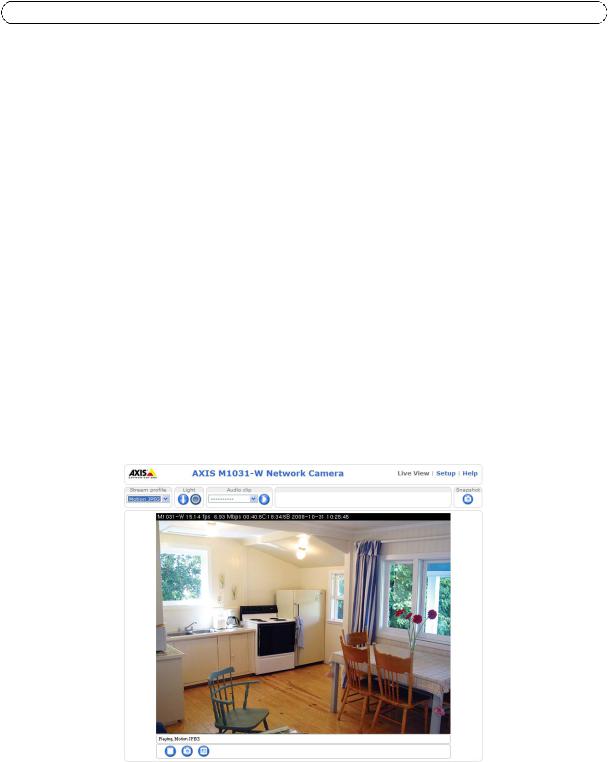
AXIS M1011/M1011-W/M1031-W - Accessing the Camera
Accessing the Camera
To install the AXIS M1011/M1011-W/M1031-W network cameras, refer to the installation guide supplied with your product.
The network camera can be used with most standard operating systems and browsers. The recommended browser is Microsoft Internet Explorer with Windows, Safari with Macintosh and Mozilla Firefox with other operating systems. See Technical Specifications, on page 41.
Notes:
•To view streaming video in Microsoft Internet Explorer, set your browser to allow ActiveX controls and install AXIS Media Control (AMC) on your workstation.
•QuickTimeTM is also supported for viewing H.264 and MPEG-4 streams and for audio.
•If your computer restricts the use of additional software components, the camera can be configured to use a Java applet for viewing Motion JPEG.
•The network camera includes one (1) H.264 decoder license and one (1) MPEG-4 decoder license for viewing video streams, and (1) AAC audio license (AXIS M1031-W). They are automatically installed with AMC. The administrator can disable the installation of the decoders to prevent installation of unlicensed copies.
Access from a browser
1.Start a browser (Internet Explorer, Firefox).
2.Enter the IP address or host name of the camera in the Location/Address field of your browser.
To access the camera from a Macintosh computer (Mac OSX), click on the Bonjour tab and select the AXIS M1011/M1011-W/M1031-W from the drop-down list.
3.If this is the first time you are accessing the camera, see Access from the Internet, on page 8. Otherwise enter your user name and password, set by the administrator.
4.The camera’s Live View page appears in your browser.
Note:
The layout of the Live View page may have been customized to specific requirements. Consequently, some of the examples and functions featured here may differ from those displayed on your own Live View page.
7
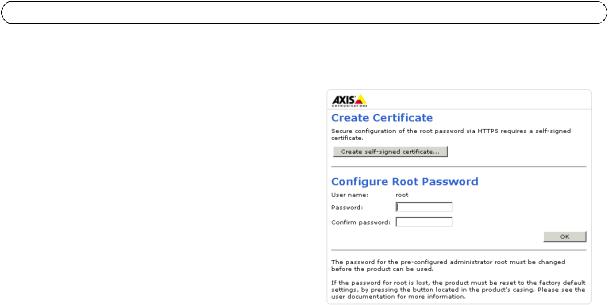
AXIS M1011/M1011-W/M1031-W - Accessing the Camera
Setting the root password
1.When accessing the camera for the first time, the ‘Configure Root Password’ dialog appears.
2.Enter a password and re-enter to confirm. Click OK. The
Enter Network Password dialog appears.
3.Enter the User name: root
4.Enter the password set in step 2, and click OK. If the password is lost, the camera must be reset to the factory default settings. See page 35.
Notes:
•The default administrator user name ‘root’ is permanent and cannot be deleted.
•While setting the root password, click Yes to install the AXIS Media Control (AMC), if you are prompted to. You will need administrator rights on the computer to do this.
Access from the Internet
Once connected, the camera is accessible on your local network (LAN). To access the camera from the Internet you must configure your broadband router to allow incoming data traffic to the camera. To do this, enable the NAT-traversal feature, which will attempt to automatically configure the router to allow access to the camera. This is enabled from Setup > System Options > Network > TCP/IP Advanced.
For more information, please see. See also the AXIS Internet Dynamic DNS Service at www.axiscam.net For Technical notes on this and other topics, visit the Axis Support web at www.axis.com/techsup
8
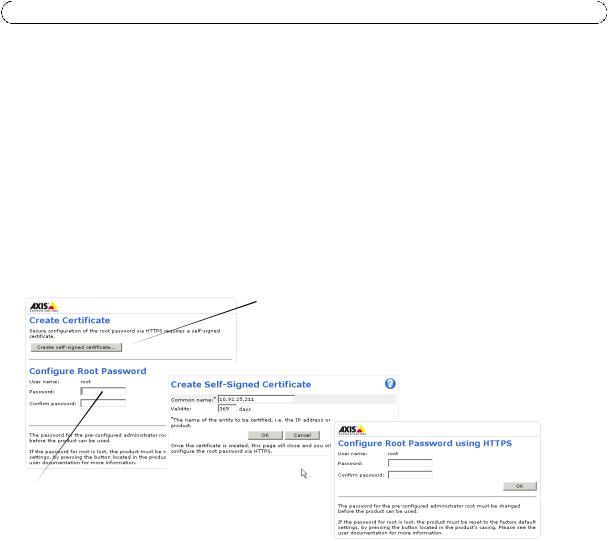
AXIS M1011/M1011-W/M1031-W - Accessing the Camera
Setting the root password over a secure connection
To gain access to the product, you must set the password for the default administrator user - ‘root’. This is done in the ‘Configure Root Password’ dialog, which appears when the network camera is accessed for the first time.
To prevent network eavesdropping, the root password can be set via an encrypted HTTPS connection, which requires an HTTPS certificate (see notes below).
To set the password via a standard HTTP connection, enter it directly in the first dialog shown below.
To set the password via an encrypted HTTPS connection, follow these steps:
1.Click the Create self-signed certificate button.
2.Provide the requested information and click OK. The certificate is created and the password can now be set securely. All traffic to and from the network camera is encrypted from this point on.
3.Enter a password and then re-enter it to confirm the spelling. Click OK. The password has now been configured.
To create an HTTPS connection, click this button.
To configure the password directly via an unencrypted connection, enter the password here.
Notes:
•HTTPS (Hypertext Transfer Protocol over SSL) is a protocol used to encrypt the traffic between web browsers and servers. The HTTPS certificate controls the encrypted exchange of information.
•The default administrator user root cannot be deleted.
•If the password for root is lost or forgotten, the network camera must be reset to the factory default settings. See page 35.
•A warning may pop up in the browser due to the fact that the certificate is self-signed and not signed by a Trusted Certificate Authority (CA).
9

AXIS M1011/M1011-W/M1031-W - Accessing the Camera
The Live View page
How you customize the Live View page determines which buttons are visible. Not all the buttons described below will show up unless configured to do so.
General controls
The Stream Profile drop-down list allows you to select a customized or pre-programmed stream profile on the Live View page. Stream profiles are configured under Video & Audio > Stream Profiles, see Stream Profiles, on page 15 for more information.
Light (Active/Inactive) - The built-in light can be controlled directly from the Live View page. The three options are Pulse, Active/Inactive and a Slider. Select Active/Inactive to display a button for each action: Activate and Inactivate. The light button is configured under Live View Config > Layout. For more information see Layout, on page 19.
Light (Pulse) - Select Pulse to display one button that activates the port with the defined Activate and Inactivate actions for the defined period.
Light (Slider) - Use this slider to adjust the brightness of the camera’s white LED.
Audio clip - Audio clips can be played when an event occurs or manually from the Live View page.
The Snapshot button saves a snapshot of the video image on display. Right-click on the video image to save it in JPEG format on your computer. This button is primarily intended for use when the AMC viewer toolbar is not available.
AXIS Media Control (AMC) toolbar
AMC general controls
The AMC viewer toolbar (AXIS Media Control) is available in Microsoft Internet Explorer only. See AXIS Media Control (AMC), on page 13 for more information. AMC displays the following buttons:
The Play button connects to the Axis product and starts playing a media stream.
The Stop button stops the video stream being played.
The Snapshot button takes a snapshot of the current image. The location where the image is saved can be specified using the AXIS Media Control (AMC).
Click the View Full Screen button and the video image will fill the entire screen. Press Esc (Escape) on the computer keyboard to cancel full screen view.
The Record button is used to record the current video stream. The location where the recording is saved can be specified using the AXIS Media Control (AMC) toolbar.
10

AXIS M1011/M1011-W/M1031-W - Accessing the Camera
AMC audio controls (AXIS M1031-W)
AMC audio controls monitor the client computer’s speaker output. These controls are only available when audio is enabled.
Click the Speaker Button to switch the sound off and on to your computer's speaker.
If you have set your network camera to half-duplex mode and the half-duplex Listen button appears first in the live view page of your Axis network camera, you are only able to receive audio from an external camera microphone. To be able to send audio, click this button. See note below.
If you have set your network camera to half-duplex mode and the half-duplex Talk button appears in the live view page of your Axis network camera if you push to talk, and you are only able to send audio to your Axis network camera. To be able to receive audio, click this button.
Click the Microphone button to switch the sound off and on to your computer's microphone.
In Simplex - Network Camera speaker only mode, you can click this button to stop sending audio to the network camera. See note below.
Use this slider to control the volume of the speakers and the microphone.
Note:
In Simplex – speaker only or microphone only mode, you can use either the Microphone button or the half-duplex Talk button to stop sending audio to the network camera. To send audio, both buttons must be enabled.
11

AXIS M1011/M1011-W/M1031-W - Video Streams
Video Streams
The network camera provides several image and video stream formats. Your requirements and the properties of your network will determine the type you use.
The Live View page in the network camera provides access to H.264, Motion JPEG, and MPEG-4 video streams, and to the list of available stream profiles. Other applications and clients can also access these video streams/images directly, without going via the Live View page.
How to stream MPEG-4/H.264
This video compression standard makes good use of bandwidth, and can provide high quality video streams at less than 1 Mbit/s.
Deciding which combination of protocols and methods to use depends on your viewing requirements, and on the properties of your network. The available options in AMC are:
Unicast RTP |
This unicast method (RTP over UDP) should |
|
|
|
be your first consideration for live unicast |
|
|
|
video, especially when it is important to |
|
|
|
always have an up-to-date video stream, |
Unicasting is used for video-on-demand broadcasting, |
|
|
even if some images are dropped. |
||
|
|
so that there is no video traffic on the network until a |
|
RTP over RTSP |
This unicast method (RTP tunneled over |
client connects and requests the stream. |
|
|
RTSP) is useful as it is relatively simple to |
|
|
|
configure firewalls to allow RTSP traffic. |
Note that there is a maximum of 20 simultaneous uni- |
|
|
|
cast connections. |
|
RTP over RTSP over |
This unicast method can be used to traverse |
||
|
|||
HTTP |
firewalls. Firewalls are commonly configured |
|
|
|
to allow the HTTP protocol, thus allowing |
|
|
|
RTP to be tunneled. |
|
|
|
|
|
|
Multicast RTP |
This method (RTP over UDP) should be used for live multicast video. The video stream is always |
||
|
up-to-date, even if some images are dropped. |
|
|
|
Multicasting provides the most efficient usage of bandwidth when there are large numbers of cli- |
||
|
ents viewing simultaneously. A multicast broadcast cannot however, pass a network router unless |
||
|
the router is configured to allow this. It is not possible to multicast over the Internet, for example. |
||
|
Note also that all multicast viewers count as one unicast viewer in the maximum total of 10 |
||
|
simultaneous connections. |
|
|
|
|
|
|
AMC negotiates with the camera to determine the transport protocol to use in the order listed above. This order can be changed and the options disabled, to suit specific requirements.
Important!
H.264, MPEG-4, and AAC (AXIS M1031-W), are licensed technologies. The network camera includes one H.264 viewing client license and one MPEG-4 viewing client license, and one audio client license. Installing additional unlicensed copies of the clients is prohibited. To purchase additional licenses, contact your Axis reseller.
12
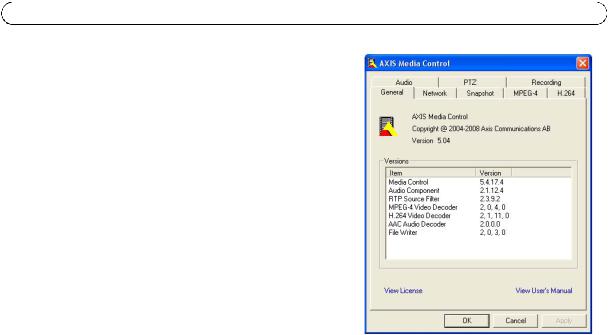
AXIS M1011/M1011-W/M1031-W - Video Streams
AXIS Media Control (AMC)
AXIS Media Control (AMC) in Microsoft Internet Explorer in Windows is the recommended method of accessing live video from the network camera.
The AMC control panel can be used to configure various video and audio settings. Please see the readme file included in the tool for more information.
The AMC control panel is automatically installed on first use, after which it can be configured. Open the AMC Control Panel from:
•Windows Control Panel (from the Start menu)
•Alternatively, right-click the video image in Internet Explorer and click Settings to access the AMC window.
Motion JPEG
This format uses standard JPEG still images for the video stream. These images are then displayed and updated at a rate sufficient to create a stream that shows constantly updated motion.
The Motion JPEG stream uses considerable amounts of bandwidth, but provides excellent image quality and access to every image contained in the stream. The recommended method of accessing Motion JPEG live video from the network camera is to use the AXIS Media Control (AMC) in Microsoft Internet Explorer in Windows.
Alternative methods of accessing the video stream
You can also access video/images from the network camera in the following ways:
•Motion JPEG server push (if supported by the client, Firefox, for example). This option maintains an open HTTP connection to the browser and sends data as and when required, for as long as required.
•Still JPEG images in a browser. Enter the path - http://<ip>/axis-cgi/jpg/image.cgi
•Windows Media Player. This requires AMC and the MPEG-4/H.264 viewing client to be installed. The paths that can be used are listed below in the order of preference:
•Unicast via RTP: axrtpu://<ip>/axis-media/media.amp
•Unicast via RTSP: axrtsp://<ip>/axis-media/media.amp
•Unicast via RTSP, tunneled via HTTP: axrtsphttp://<ip>/axis-media/media.amp
•Multicast: axrtpm://<ip>/axis-media/media.amp
•To access the video stream from QuickTime™ the following paths can be used:
•rtsp://<ip>/axis-media/media.amp
•rtsp://<ip>/axis-media/media.3gp
Notes:
•The network camera supports QuickTime 6.5.1 and later.
•QuickTime adds latency to the video and audio stream (up to 3 seconds).
•It may be possible to use other players to view the MPEG-4/H.264 stream using the paths above, although Axis does not guarantee this.
•<ip> = IP address
13
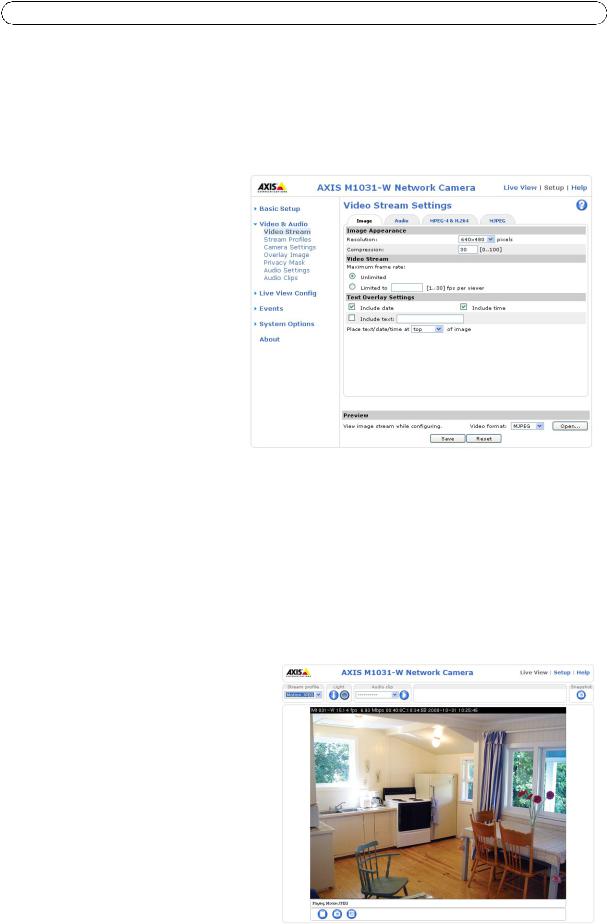
AXIS M1011/M1011-W/M1031-W - Video & Audio Settings
Video & Audio Settings
This section describes how to configure the camera, and is intended for product Administrators, who have unrestricted access to all settings; and Operators, who have access to the settings for Basic Setup, Video & Audio and Events.
You can configure the camera by clicking Setup in the top right-hand corner of the Live View page. Click  on this page to access the online help that explains the setup tools.
on this page to access the online help that explains the setup tools.
Video Stream
The video stream settings appear under four different tabs:
•Image
•Audio (AXIS M1031-W)
•H.264 & MPEG-4
•MJPEG
Image
Image Appearance
Use these settings to modify the image resolution and compression. Setting the compression level affects the image quality and the amount of bandwidth required; the lower the compression, the higher the image quality with higher bandwidth requirements.
See the online help files  for more information.
for more information.
Video Stream
To avoid bandwidth problems on the network, the frame rate allowed to each viewer can be limited. Select the Unlimited radio button option to allow the highest available frame rate; or select the Limited to radio button option and enter a value (1-30) fps in the field.
Text Overlay Settings
Use these settings to include text, date, and time as overlay. Click  for information on available options.
for information on available options.
Preview
For a preview of the image before saving the adjusted settings, select the Video Format and click Open.... When satisfied with the settings, click Save.
Audio (AXIS M1031-W)
Check the Enable Audio option to enable audio.
Text, date & time
& time
overlay
14

AXIS M1011/M1011-W/M1031-W - Video & Audio Settings
Configuration settings from Video & Audio > Audio Settings are displayed under Current Audio Settings. See Audio Settings (AXIS M1031-W), on page 17 for more information on the audio settings.
H.264 & MPEG-4
GOV Settings
The GOV structure describes the composition of the video stream. Setting the GOV-length to a higher value saves considerably on bandwidth but may have an adverse effect on image quality.
Bit Rate Control
The bit rate can be set as Variable Bit Rate (VBR) or Constant Bit Rate (CBR).
VBR adjusts the bit rate according to the image complexity, using more bandwidth for increased activity in the image, and less for lower activity.
CBR allows you to set a fixed Target bit rate that consumes a predictable amount of bandwidth. As the bit rate would usually need to increase for increased image activity, but in this case cannot, the frame rate and image quality are affected negatively. To partly compensate for this, it is possible to prioritize either the frame rate or the image quality whenever the bit rate needs to be increased. Not setting a priority means the frame rate and image quality are equally affected.
Note:
•To determine a reasonable bit rate, go to Setup > Video & Audio > Video Stream > Image, check the Include checkbox and enter the code #b in the Include text: field. The current bit rate will display as a text overlay on the Live View page.
•To view the image stream while configuring the GOV settings and Bit rate control, select Open... under Preview.
MJPEG
Sometimes the image size is large due to low light or complex scenery. Adjusting the maximum frame size helps to control the bandwidth and storage used by the Motion JPEG video stream in these situations. Defining the frame size as Unlimited provides consistently good image quality at the expense of increased bandwidth and storage usage during low light. Limiting the frame size optimizes bandwidth and storage usage, but may give poor image quality. To prevent increased bandwidth and storage usage, the maximum frame size can be limited.
Stream Profiles
There are four pre-programmed stream profiles available for quick set-up. These settings can be adjusted and new customized profiles can be created. Each profile has a descriptive name, describing its usage and/or purpose. The profiles can be accessed from the Live View page.
•To add a new stream profile, click Add to bring up the Stream Profile Settings dialog.
•Choose a descriptive name and enter a description for your profile.
•Choose the form of Video encoding you wish to use from the drop-down list:
H.264 - Also known as MPEG-4 Part 10. This is the new generation compression standard for digital video. This function offers higher video resolution than Motion JPEG or MPEG-4 at the same bit rate and bandwidth, or the same quality video at a lower bit rate.
MPEG-4 part 2 - A video compression standard for digital video.
Motion JPEG - Delivers a high quality video stream, from which individual images can be extracted and saved.
•Copy an existing stream profile to your system and rename the copy.
•Modify an existing stream profile based on the light situation and motion to be captured by your camera. See Stream Profile Settings for more information.
•Highlight the stream profile you wish to remove, then click Remove to remove it from the list.
15

AXIS M1011/M1011-W/M1031-W - Video & Audio Settings
Camera Settings
This page provides access to the advanced image settings for the AXIS M1011/M1011-W/M1031-W.
Image Appearance
Color level - Select an appropriate level by entering a value in the range 0-100. Lower values mean less color saturation, whilst the value 100 gives maximum color saturation.
Brightness - The image brightness can be adjusted in the range 0-100, where a higher value produces a brighter image.
Sharpness - Controls the amount of sharpening applied to the image. A sharper image might increase image noise especially in low light conditions. A lower setting reduces image noise, but the image would be less sharp.
Contrast - Adjust the image's contrast by raising or lowering the value in this field.
Rotate image - The image can be rotated to the correct orientation. Select the appropriate value from the drop-down list.
White balance
This is used to compensate for the different colors present in different light sources, to make the colors in the image appear the same. The AXIS M1011/M1011-W/M1031-W can be set to automatically identify the light source and compensate for its color. Alternatively, the type of light source can be manually selected from the drop-down list. Please see the online help files  for a description of each available setting.
for a description of each available setting.
Exposure Settings
Configure the exposure settings to suit the image quality requirements in relation to lighting, frame rate and bandwidth considerations.
Exposure value - Increasing the exposure will improve image quality at the expense of the total frame rate. There may also be an increase in motion blur.
Exposure control - This setting is used to remove 50/60 Hz flicker.
Enable Backlight compensation - Backlight compensation makes the subject appear clearer when the image background is too bright, or the subject too dark.
Exposure zones - This setting determines which part of the image is used to calculate the exposure.
Exposure priority - This defines the balance between image quality and the frame rate. When Motion is prioritized, motion blur is minimized, but the image quality may be reduced with a higher frame rate. A prioritized Low noise will provide better image quality with a lower frame rate.
View Image Settings
Click View to view the video stream with the current configuration. Once satisfied, click Save.
Overlay Image
An overlay image is a static image superimposed over the video image. An overlay can be used to provide extra information, or to mask a part of the video image.
To use an overlay image in the AXIS M1011/M1011-W/M1031-W Network Camera, it must be selected from the drop-down list of available images. The overlay (a logo, for example) is then displayed in the video image.
To use your own image, first upload it to the AXIS M1011/M1011-W/M1031-W Network Camera. To upload enter the name of the file in the field provided, or click the Browse button, locate and click the Upload button.
16
